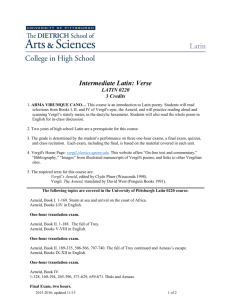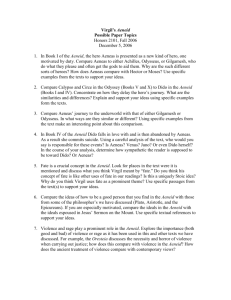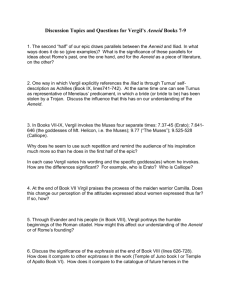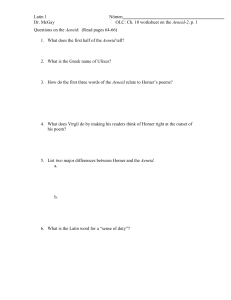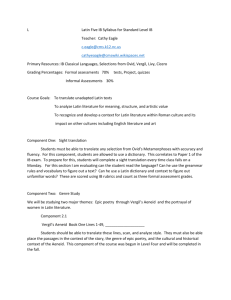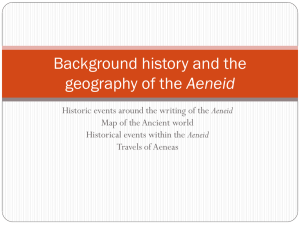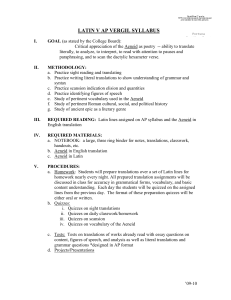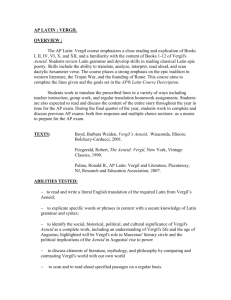Academic Journal of Modern Philology Vol. 2 2013
advertisement
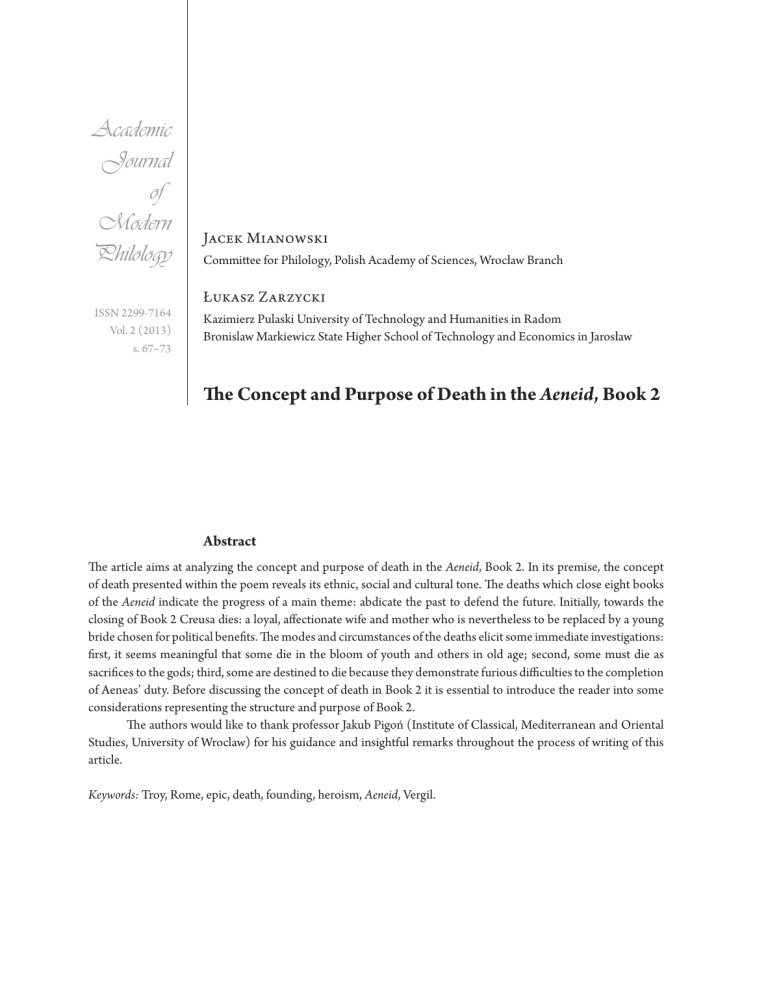
Academic Journal of Modern Philology Jacek Mianowski Committee for Philology, Polish Academy of Sciences, Wrocław Branch Łukasz Zarzycki ISSN 2299-7164 Vol. 2 (2013) s. 67–73 Kazimierz Pulaski University of Technology and Humanities in Radom Bronislaw Markiewicz State Higher School of Technology and Economics in Jarosław The Concept and Purpose of Death in the Aeneid, Book 2 Abstract The article aims at analyzing the concept and purpose of death in the Aeneid, Book 2. In its premise, the concept of death presented within the poem reveals its ethnic, social and cultural tone. The deaths which close eight books of the Aeneid indicate the progress of a main theme: abdicate the past to defend the future. Initially, towards the closing of Book 2 Creusa dies: a loyal, affectionate wife and mother who is nevertheless to be replaced by a young bride chosen for political benefits. The modes and circumstances of the deaths elicit some immediate investigations: first, it seems meaningful that some die in the bloom of youth and others in old age; second, some must die as sacrifices to the gods; third, some are destined to die because they demonstrate furious difficulties to the completion of Aeneas’ duty. Before discussing the concept of death in Book 2 it is essential to introduce the reader into some considerations representing the structure and purpose of Book 2. The authors would like to thank professor Jakub Pigoń (Institute of Classical, Mediterranean and Oriental Studies, University of Wroclaw) for his guidance and insightful remarks throughout the process of writing of this article. Keywords: Troy, Rome, epic, death, founding, heroism, Aeneid, Vergil. Jacek Mianowski, Łukasz Zarzycki 1. The text and the reader 68 When one comes in contact with the Aeneid for the first time, the relation between the text and the reader is established. Each and every reader is likely to perceive the text differently and the first reading usually provides a merely blank idea of the contents and the plot. When one takes a closer look, however, several peculiarities start to appear. The Aeneid is not a text that lends itself easily to a thorough analysis. One may consider the structuring of the text, divided into twelve books, each having its own purpose and significance. Book II is hardly an exception in this regard. Vergil’s ideas on poetic structuring may seem unique. The political and historical background of the Aeneid shows that the underlying purpose for its origin lies in the ethnic, social and cultural motivation. The poem itself, written within around eleven years, was missing some revisions at the time of Vergil’s death (Dixon-Kennedy 1998: 14). As it was suggested by Reed (2007: 1), it became one of the most wellknown examples of Roman ktisis poetry, or a “foundation myth.” It may be worth noting, however, that Vergil’s idea of strengthening the political influence of Augustus and providing his compatriots with an ethnic point-of-reference was not a genuine concept. Ktisis myths were already known in ancient Greece, while Vergil’s ideas were strongly influenced by poetical works of Homer. According to Kenneth Quinn (1968: 42–43): [Vergil’s] poem expressly recalls Homer’s story and constantly evokes Homer’s conventions. The storm in Book 1, the games in Book 5, the journey to the underworld in Book 6, Aeneas’ shield in Book 8, the night raid of Nisus and Euryalus in Book 9, the avenging of Pallas in Books 10 to 12, the duel in Book 12—all these have their obvious antecedents in the Illiad and the Odyssey: the parallels are close and sustained. (…) Finally, the structure of the poem is Homeric: the divine machinery, the rules Virgil imposes on himself for what may be said and what left unsaid follow Homeric practice. Yet for all this, Virgil’s poem remains consciously, fundamentally, and unmistakably, Roman. The “Roman particle,” as Brooks Otis (1963: 39) indicated, was the raising tendency of that time and gave birth to the res Romanae which developed the principles of epic formulated in Horace’s Ars Poetica and was vital in both poetic and social terms. From this perspective the Aeneid may seem to be a wellbalanced hybrid of Greek traditions and Roman novelties. At some point the reader is likely to realise that Greek traditions discernible from the text were not placed there exactly in their original form. It may be stated that Vergil has shown a remarkable skill of intertwining the Greek ideas of plot organisation, epic strory-telling, or the concept of protagonist’s evolution, while revoking the aggregative poetic forms or archaic ideas of conceptualising and verbalising information, all of which were remnants of oral residue.1 2. The internal struggle The Aeneid is, in its essence, a poem about a leader who has to come to terms with his own inabilities and undergo a gradual and fundamental change.2 By learning through trial and error he maintains a better grasp of his leadership skills and gets to understand that his success is more than just a matter of chance and luck 1 See: Ong ([1982] 2002, Havelock 1986). 2 Although it remains unclear whether this change comes to pass. The Concept and Purpose of Death in the Aeneid, Book 2 (Quinn 1968: 54). In terms of Augustan ideology, the protagonist personifies every trait that should be characteristic of a Roman citizen. The “ideal every-man” achieves his position in the world through a long and fierce struggle. This struggle for pietas, as Otis calls it (1963: 223, 241), has to be achieved by the hero who undergoes an internal change. The change does not come easily, as the constant struggle between furor, the internal rage and anxiousness to avenge the deaths of relatives and countrymen, and pietas, the newly formed set of traits resembling the essence of internal integrity and acceptance of what happened and what is to come, is visible throughout the whole poem. The change takes place in the very middle of the story and, as Otis remarks (1963: 223), it pinpoints “the difference between the hero’s preparation for victory and the actual winning of it.” The story of the hero’s internal struggle plays therefore a fundamental role in shaping of Roman identity. 3. The Aeneid, Book 2: structure and purpose It may be discussed what was the principle behind the division of the Aeneid into twelve books. Vergil has managed to divide his poem while retaining proportions and harmony not only in terms of number of books and their contents, but also in terms of internal structure of each book. It was indicated by Quinn (1968: 64) that this meticulous way of weaving poetry was carefully planned and well executed: The lasting power of a work like the Aeneid to hold our interest and affection has much to do with the complex relationship of the different parts of the total structure to one another and to the whole. Changes in mood, tempo and narrative technique form a continually varying pattern comparable to that formed by the different movements and parts of movements of a symphony. Beyond that, the division is discernible in terms of grouping of books. Quinn remarks (1968: 65–67) that aside from the first six books being more complicated in terms of structure, Books 2 and 3 can be easily marked as the odd ones. This is the result of the change in narration technique in which the reader is allowed to see the events from the perspective of Aeneas. Furthermore, Book 2 ends with a Tableau whose role is to track away the events. Each tableau within poem has its own central character and within Book 2 this role is fulfilled by Aeneas. What is perhaps most striking in Book 2 is the flashback narration. Even within the first opening lines the reader is likely to notice that his attention is being directed not to the contents or plot, but to the person of the narrator himself: There were all silent, and turned their faces towards intently. Then from his high couch our forefather Aeneas began: ‘O queen, you command me to renew unspeakable grief, How the Greeks destroyed the riches of Troy and the sorrowful kingdom, miseries I saw myself, and in which I played a great part.3 The purpose of this is twofold. Firstly, the change in narration seeks to immerse the reader even further into the plot and to avoid monotony. Secondly, having Aeneas as the narrator, Vergil seeks to establish an emotional relation between the reader, the narrator and the story itself. The structure of Book 2 was 3 Aeneid, Book 2, p. 34. Translated by A. S. Kline, 2002. Source: www.poetryintranslation.com 69 Jacek Mianowski, Łukasz Zarzycki 70 also divided into two or three discernible parts. Otis (1963: 246–247) indicates that the division starts at Laocoon and his desperate plea to revoke the Greek gift, with a subsection devoted to the scene of death of Laocoon and his sons. The second section starts with Anchises and the oracles and ends with the departure of Aeneas and his family. Much attention is paid to the omens of flame and comet along with their interpretations. A similar division was proposed by Quinn (1968: 114–115), yet his idea varies in terms of distinguishing a separate section for the scenes of fighting within Troy. 4. Heroism of death in Book 2 Book 2 is highly metaphorical in its essence. Even though its most preliminary function is to acquaint the reader with the chronology of Greek attack and the fall of Troy, the subliminal messaging is easy to discern. The city falls not simply because of the folly of its inhabitants. It falls because it is destined to do so. This allegorical background of the fall of the city was also viewed by Putnam (2010: 85), as: (…) a metaphor for the death of the poet himself, his death above all to the city that inspired him. Troy’s death is experienced as his interior woe. For Aeneas, in spite of the hurt brought by the ruin of his homeland, there is a “Rome” in the future to anticipate positively, with an Augustan golden age to come. The fate of Aeneas is also allegorical from the perspective of the mortal-divine conflict. Aeneas becomes a “prey of circumstances” (Putnam 2010: 87) and has to survive the malice of Juno. A similar analogy can be applied to Troy’s citizens. Even though they are given four signs of the forthcoming destruction, they avoid acknowledging them. At the same time Quinn argues (1968: 118) that “[i]t is not the intention to warn the Trojans. Their interpreting of the signs as they do interpret them was, in emotional circumstances, inevitable.” Inevitability of what is to come may be seen as the leitmotif of Book 2. The death of Laocoon and his sons seems to support this idea. The beginning of the scene views Laocoon performing his chores and the appearance of the snakes is introduced in a rapid manner: Then something greater and more terrible befalls us wretches, and stirs our unsuspecting souls. Laocoon, chosen by lot as priest of Neptune, was sacrificing a huge bull at the customary altar. See, a pair of serpents with huge coils, snaking over the sea from Tenedos through the tranquil deep (I shudder to tell it), and heading for the shore side by side: their fronts lift high over the tide, and their blood-red crests top the waves, the rest of their body slides through the ocean behind, and their huge backs arch in voluminous folds.4 From the description one can easily assume that the snakes were obviously no mere animals, which found themselves in the wrong place or time. They were brought upon Laocoon on purpose and fulfilled their role skilfully. Laocoon’s death is quick, yet rather painful, even though he tries to defend himself and his 4 Aeneid, Book 2, p. 39. Translated by A. S. Kline, 2002. Source: www.poetryintranslation.com The Concept and Purpose of Death in the Aeneid, Book 2 progeny. At the very end of the scene, as Quinn (1968: 117) notes, snakes escape and hide within the temple of Minerva. One cannot fail to see the symbolic alliance of Minerva and Neptune in order to remove the last personification of resistance towards inevitable fate. The death of Laocoon and his family is hardly heroic; it is a skilfully planned and executed endeavour that seeks to demonstrate divine power. The message sent to all who witness Laocoon’s fall is clear: Aeneas understands5 that the gods no longer support the city and he needs to escape; the citizens perceive Laocoon’s death as a punishment for his defiance and command the horse to be brought within city walls. Moreover, Laocoon’s fall is more than just a symbol for Trojans. As Pigoń (2011: 323) remarks, “Vergil’s reason for introducing Laocoon into his narrative, and for starkly emphasizing his role during the last hours of the town, is to use his plight as a foreshadowing, an epitome, of the fall of Troy.” One can observe the full spectrum of symbolism, yet it is hard to discern heroism in the circumstances of Laocoon’s end. When fighting starts within the city walls, the narration seems to gain momentum. Aeneas starts to shift the narration from one place to another and allows himself to comment on the events which he retells. He sees his fellow comrades ready for battle and thirsty for vengeance (verse 348), yet he is unwilling to give them any comfort (verse 345): “The beaten have one refuge, to have no hope of refuge.” When the battle commences, ingenious Trojans come up with the idea of disguising themselves in Greek armours. Yet, their plot is soon discovered when they attempt to save Priam’s daughter. They become outnumbered and have to face the inevitable fate: Even those we have scattered by a ruse, in the dark of night, and driven right through the city, re-appear: for the first time they recognise our shields and deceitful weapons, and realise our speech differs in sound to theirs. In a moment we’re overwhelmed by weight of numbers: first Coroebus falls, by the armed goddess’s altar, at the hands of Peneleus: and Ripheus, who was the most just of all the Trojans, and keenest for what was right (the gods’ vision was otherwise): Hypanis and Dymas die at the hands of allies: and your great piety, Panthus, and Apollo’s sacred headband cannot defend you in your downfall. Ashes of Ilium, death flames of my people, be witness that, at your ruin, I did not evade the Danaan weapons, nor the risks, and, if it had been my fate to die, I earned it with my sword.6 The scene of battle for the palace maintains the same momentum in narration. The reader is quickly taken into the halls of the keep and witnesses the story as if he were Aeneas’ companion. At one point Aeneas slows down the pace of narration and focuses on the scene of Priam’s death. He describes Priam’s attempts of defence, as he puts on his rusty armour, the woes of his wife and daughters and the moment when Priam gets to see his own son die: 5 Aeneas seems to recognise his stance with gods afterwards his escape. 6 Aeneid, Book 2, p. 46. Translated by A. S. Kline, 2002. Source: www.poetryintranslation.com 71 Jacek Mianowski, Łukasz Zarzycki See, Polites, one of Priam’s sons, escaping Pyrrhus’s slaughter, runs down the long hallways, through enemies and spears, and, wounded, crosses the empty courts. Pyrrhus chases after him, eager to strike him, and grasps at him now, and now, with his hand, at spear-point. When finally he reached the eyes and gaze of his parents, he fell, and poured out his life in a river of blood. Priam, though even now in death’s clutches, did not spare his voice at this, or hold back his anger: “If there is any justice in heaven, that cares about such things, may the gods repay you with fit thanks, and due reward for your wickedness, for such acts, you who have made me see my own son’s death in front of my face, and defiled a father’s sight with murder. Yet Achilles, whose son you falsely claim to be, was no such enemy to Priam: he respected the suppliant’s rights, and honour, and returned Hector’s bloodless corpse to its sepulchre, and sent me home to my kingdom.” So the old man spoke, and threw his ineffectual spear without strength, which immediately spun from the clanging bronze and hung uselessly from the centre of the shield’s boss. Pyrrhus spoke to him: “Then you can be messenger, carry the news to my father, to Peleus’s son: remember to tell him of degenerate Pyrrhus, and of my sad actions: now die.” Saying this he dragged him, trembling, and slithering in the pool of his son’s blood, to the very altar, and twined his left hand in his hair, raised the glittering sword in his right, and buried it to the hilt in his side. This was the end of Priam’s life: this was the death that fell to him by lot, seeing Troy ablaze and its citadel toppled, he who was once the magnificent ruler of so many Asian lands and peoples. A once mighty body lies on the shore, the head shorn from its shoulders, a corpse without a name.7 72 The image of Priam’s death is horrid. Yet, it is simply another way of presenting the inevitable. Priam’s death is certain, but he decides to die on his own terms. What he fails to foresee, however, is that he has to face the death of his son before his own. Even though tragedies take place throughout the whole book the irony stems from the evanescent feeling that there is a “master plan” hidden beneath each and every incident. Death in Book 2 always happens “because of.” At the first glance one can easily conclude that there is neighter heroism, nor glory in the way protagonists face their end. There is hardly any sacrifice for the sake of Troy—no matter the choices, the city falls. Even if heroes decide to keep the last remnants of power they possess and make a decision to die how they see fit, fate always finds a way of crushing these 7 Aeneid, Book 2, p. 49. Translated by A. S. Kline, 2002. Source: www.poetryintranslation.com The Concept and Purpose of Death in the Aeneid, Book 2 smallest glimmers of hope. Yet, there is a certain “order” in which all these deaths happen. As it is noted by Michèle Lowrie (2010: 392), “violence in the Aeneid operates within the workings of power.” Law and ultimate justice are the essence of every killing that takes place throughout the whole narrative. Law does not justify the Greek deeds, yet it is the “sanctioned violence” that takes place. Lowrie believes (2010: 394), that all instances of violence are foundational and that due to the deaths of Laocoon, Priam and Aeneas’ comrades the imperium Romanum can be born. The foundation myth has therefore the purpose not to glorify the memory of fallen Trojan heroes, but to mark the fact that it was through blood and sacrifice of others that a new empire could be born. References Dixon-Kennedy, Mike (1998) Encyclopedia of Greco-Roman Mythology. Santa Barbara, Denver, Oxford: ABCCLIO. Lowrie, Michèle (2010) “Vergil and Founding Violence.” [In:] A Companion to Vergil’s Aeneid and its Tradition. Joseph Farrell, Michael C. J. Putnam (eds.). Maldon, Oxford: Blackwell Publishing; 391–403. Otis, Brooks (1963) Virgil. A Study in Civilized Poetry. Oxford: Clarendon Press. Pigoń, Jakub (2011) “A Priest, Two Snakes, and a Bull. The Laocoon Episode in The Aeneid Once Again.” [In:] Birthday Beast’s Book. Where Human Roads Cross Animal Trails. Cultural Studies in Honour of Jerzy Axer. Małgorzata Borowska, Jan Kieniewicz, Przemysław Kordos (eds.). Warsaw: Institute for Interdisciplinary Studies “Artes Liberales”—Wydawnictwo “Wilczyska;” 321–334. Putnam, Michael C. J. (2010) “Vergil, Ovid, and the Poetry of Exile.” [In:] A Companion to Vergil’s Aeneid and its Tradition. Joseph Farrell, Michael C. J. Putnam (eds.). Maldon, Oxford: Blackwell Publishing; 80–95. Quinn, Kenneth (1968) Virgil’s Aeneid. A Critical Description. London: Routledge & Kegan Paul. Reed, J. D. (2007) Virgil’s Gaze. Nation and Poetry in the Aeneid. Princeton, Oxford: Princeton University Press. Secondary sources Havelock, Eric A. (1986) The Muse Learns to Write. Reflections on Orality and Literacy from Antiquity to the Present. New Haven, London: Yale University Press. Ong, Walter ([1982] 2002) Orality and Literacy. London, New York: Routledge. Literary references Vergil [29–19 BC] The Aeneid. Translated by A. S. Kline. An online reference, available at: www. poetryintranslation.com. Last accessed 19.06.2011. 73
